

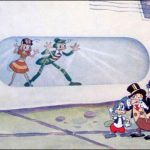

I thought I’d do something a little different this week. Rather than a whole film, talk specifically about a sequence from a feature film from a direction standpoint.
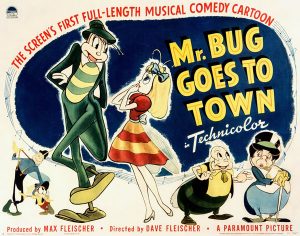 Mr. Bug Goes to Town (1941) seems to always get the shorter end of a stick in any list of the best animated features ever made. The Fleischer studio’s work in the early 40s varied greatly, from excellent to potboilers in shorts. The best of the Popeyes and certainly the Superman cartoons showed the studio’s capabilities. Mr. Bug, as a feature length story, is incredibly well directed, concisely making clear story points in short, well-designed sequences. Each sequence works in a similar way in terms of storytelling; they’re all little chapters that concentrate on making one story point clear by establishing mood, place and character action, then wrapping is as simple of a way as each started.
Mr. Bug Goes to Town (1941) seems to always get the shorter end of a stick in any list of the best animated features ever made. The Fleischer studio’s work in the early 40s varied greatly, from excellent to potboilers in shorts. The best of the Popeyes and certainly the Superman cartoons showed the studio’s capabilities. Mr. Bug, as a feature length story, is incredibly well directed, concisely making clear story points in short, well-designed sequences. Each sequence works in a similar way in terms of storytelling; they’re all little chapters that concentrate on making one story point clear by establishing mood, place and character action, then wrapping is as simple of a way as each started.
Here are three consecutive sequences from the film, encompassing 3 minutes and 49 seconds all together. I wanted to choose a less thought about section of the film that shows how the sequence direction carries the film.
 In the first sequence here, the story point shows the three bad guys (Mr. Beetle, Swat and Smack) stealing the letter with payment for Dick Dicken’s song that was sent to Famous Music (for us in the know Paramount’s music company). We start off with a simple establishing shot of the postman delivering the mail. Since we’re in the bug world, the shot doesn’t frame the action as a normal live action film would; instead, we get a shot of the postman headless, from the torso up, just as many of the other shots are executed in the film, never seeing a head shot except from a longer distance. This keeps the viewpoint of the bugs front and center, and also keeps our empathy concentrated with them. Mr Beetle orders Swat and Smack to steal the letter in a medium closeup to concentrate on character acting, then back wider to see their action taking off. The action of them actually getting the letter is done off-screen, staying on the wide shot of Mr. Beetle’s reaction as they tumble past the frame with the letter, the camera following them to the ground. Again, keeping with the feeling and viewpoint of the bugs, even though it isn’t a realistic, truly from their view-point. We cut wider to see the letter in the foreground of a longer shot, catching Mary’s legs and gearing her open the mailbox, the camera low to the ground. That shot is followed by simple action shots, medium longs and closer, showing the action of Swat and Smack hiding the letter. Fade out.
In the first sequence here, the story point shows the three bad guys (Mr. Beetle, Swat and Smack) stealing the letter with payment for Dick Dicken’s song that was sent to Famous Music (for us in the know Paramount’s music company). We start off with a simple establishing shot of the postman delivering the mail. Since we’re in the bug world, the shot doesn’t frame the action as a normal live action film would; instead, we get a shot of the postman headless, from the torso up, just as many of the other shots are executed in the film, never seeing a head shot except from a longer distance. This keeps the viewpoint of the bugs front and center, and also keeps our empathy concentrated with them. Mr Beetle orders Swat and Smack to steal the letter in a medium closeup to concentrate on character acting, then back wider to see their action taking off. The action of them actually getting the letter is done off-screen, staying on the wide shot of Mr. Beetle’s reaction as they tumble past the frame with the letter, the camera following them to the ground. Again, keeping with the feeling and viewpoint of the bugs, even though it isn’t a realistic, truly from their view-point. We cut wider to see the letter in the foreground of a longer shot, catching Mary’s legs and gearing her open the mailbox, the camera low to the ground. That shot is followed by simple action shots, medium longs and closer, showing the action of Swat and Smack hiding the letter. Fade out.
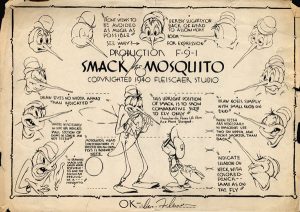 This sequence is beautifully and simply directed, with simple action and acting choices that describe the story elements in simple ways, never forgetting viewpoint. The third person direction through the sequence never worries about impressing the viewer, and keeps a consistent eye on timing to describe and not wasting a frame of time.
This sequence is beautifully and simply directed, with simple action and acting choices that describe the story elements in simple ways, never forgetting viewpoint. The third person direction through the sequence never worries about impressing the viewer, and keeps a consistent eye on timing to describe and not wasting a frame of time.
The following sequence starts with a long shot of the community at night, with lights of different houses turning on. We find out fast that the town is under attack, with one assault following another in a montage of shots that cross dissolve into each other. In each shot, the camera is place closer and closer as they (and we) are encroached upon. This is followed by a sequence, also done completely in cross-fades, with different members of the community complaining in a rhyming almost song, with many shot from dramatic angles. We see Hoppity, on his own, wandering through the community, alone, hearing the comments. This sequence ends with two important shots, The first, with Hoppity hearing from outside Mrs Ladybug inside the Honey Shoppe complaining about what Hoppity said being untrue, then the bad guys in a medium shot mocking the townspeople’s complaints.
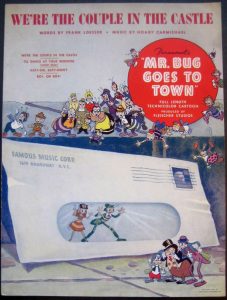 This is another beautifully executed sequence, without a frame wasted. The first part of the sequence is based on feeling for the first shot, then entirely by action for the rest, building a little faster and faster as the camera moves closer and closer to the action in each new scene. In the second part of this sequence, connected by cross fades to the first, the timing of the shots is based sometimes on feeling, sometimes on action or dialogue, but always with the idea of getting one simple point across to build into the other shots in the scene. The don’t complicate the sequence with unneeded dialogue, instead choosing to have the characters sentiments all relate to each other through rhyme and to move the sequence along. Seeing Hoppity’s silent sadness at these reactions tells everything we need to know.
This is another beautifully executed sequence, without a frame wasted. The first part of the sequence is based on feeling for the first shot, then entirely by action for the rest, building a little faster and faster as the camera moves closer and closer to the action in each new scene. In the second part of this sequence, connected by cross fades to the first, the timing of the shots is based sometimes on feeling, sometimes on action or dialogue, but always with the idea of getting one simple point across to build into the other shots in the scene. The don’t complicate the sequence with unneeded dialogue, instead choosing to have the characters sentiments all relate to each other through rhyme and to move the sequence along. Seeing Hoppity’s silent sadness at these reactions tells everything we need to know.
There’s a short transition sequence of Hoppity sadly walking silently to connect the longer sequence to the next.
The next sequence starts with Hoppity drawing a simple Honey bee face into a tree, hearing the postman coming and taking off. This medium closeup is followed by wider shots showing happily traveling fast, over to the front of the house. Hoppity jumps into the house to hear the bad news of the foreclosure of the house. We cut closer and closer until we’re at a medium closeup on Hoppity, tearing up over the news. We cut to a long shot where Dick plays and shot melody and closes the piano. The camera fades out, except for a spotlight on Hoppity.
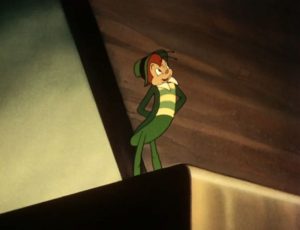 Another really well executed sequence, highlighting Hoppity viewpoint and learning that all efforts have failed. The shot design, from the pan action shots of Hoppity running to the varied shots of Hoppity finding out the news all concentrate on the best and simplest way to portray the action. I do wish the character animation of Hoppity in the closeup in this scene was better; it’s the one element that really hurts an otherwise incredibly important scene. The beautiful shot at the end of the scene, with the piano shot with a wide lens, distorting the perspective a little and keeping us both low and distant, works perfectly, as does the ending of the sequence with the spotlight on Hoppity.
Another really well executed sequence, highlighting Hoppity viewpoint and learning that all efforts have failed. The shot design, from the pan action shots of Hoppity running to the varied shots of Hoppity finding out the news all concentrate on the best and simplest way to portray the action. I do wish the character animation of Hoppity in the closeup in this scene was better; it’s the one element that really hurts an otherwise incredibly important scene. The beautiful shot at the end of the scene, with the piano shot with a wide lens, distorting the perspective a little and keeping us both low and distant, works perfectly, as does the ending of the sequence with the spotlight on Hoppity.
While Mr. Bug isn’t a perfect film, I think it’s worth noting just how well-directed many of the sequences are. One wishes the Fleischers would have had at least one more short at a feature since they had built a studio that was up to the challenge. Mr. Bug remains one of my favorite films, and while I can see things that don’t work as well, I marvel at how beautiful so many of the ideas in visual and musical form work together.
Have a good week everyone!